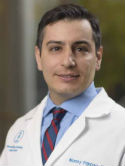Anal adenocarcinoma treated in the era of total neoadjuvant therapy and nonoperative management Journal Article
| Authors: | Feferman, Y.; Rosen, R. Y.; Gebran, S.; Yuval, J. B.; Kerioui, M.; Gönen, M.; Wei, I. H.; Widmar, M.; Nash, G. M.; Weiser, M. R.; Paty, P. B.; Hajj, C.; O'Brien, D. A. R.; Romesser, P. B.; Crane, C. H.; Smith, J. J.; Garcia Aguilar, J.; Pappou, E. P. |
| Article Title: | Anal adenocarcinoma treated in the era of total neoadjuvant therapy and nonoperative management |
| Title Series: | Diseases of the Colon and Rectum |
| Abstract: | BACKGROUND: Anal adenocarcinoma bears a treatment strategy unique to other anal cancers. OBJECTIVE: This study aimed to describe oncologic outcomes of total neoadjuvant therapy followed by watch-and-wait approach for anal adenocarcinoma. DESIGN: Retrospective analysis. SETTINGS: This study was conducted at a comprehensive cancer center. PATIENTS: Patients with anal adenocarcinoma treated between 2004 and 2019 were selected. INTERVENTIONS: Fifty-four patients received neoadjuvant therapy and were divided into 2 groups according to their treatment strategy: total neoadjuvant therapy versus single neoadjuvant modality therapy. MAIN OUTCOME MEASURES: Organ preservation, tumor regrowth, local failure, distant metastasis rates, recurrence-free survival, and overall survival. RESULTS: This study included 70 patients with anal adenocarcinoma. Fifty-four patients (77%) received neoadjuvant therapy, of whom 30 (42%) received total neoadjuvant therapy and 24 (34%) received single neoadjuvant modality. Twenty-three (33%) patients achieved complete clinical response and were managed by watch-and-wait approach. The proportion of patients able to continue to watch-and-wait approach was higher after receiving total neoadjuvant therapy (60%) compared with single neoadjuvant modality therapy (20%; p = 0.004). A tumor regrowth rate of 22% was observed in the total neoadjuvant therapy group. The 5-year overall survival rate was 70% (95% CI, 59%-83%), including 61% (95% CI, 42%-88%) for the total neoadjuvant therapy and 65% (95% CI, 48%-88%) for the single neoadjuvant modality groups. Colostomy was avoided in 50% of patients who received total neoadjuvant therapy and 83% of watch-and-wait patients. Five-year recurrence-free survival rates of 55% (95% CI, 39%-79%) and 30% (95% CI, 15%-58%) were observed in the total neoadjuvant therapy and single neoadjuvant modality groups. LIMITATIONS: Retrospective nature. CONCLUSIONS: This is the first report in the literature describing the safety and feasibility of nonoperative management for anal adenocarcinoma. Anal adenocarcinoma treated with total neoadjuvant therapy and nonoperative management achieve regrowth rates comparable to those observed in rectal cancer, with oncologic outcomes similar to those of traditional treatment strategies. See Video Abstract. ADENOCARCINOMA ANAL TRATADO EN LA ERA DE LA TERAPIA NEOADYUVANTE TOTAL Y EL TRATAMIENTO NO QUIRÚRGICO ANTECEDENTES: El adenocarcinoma anal conlleva una estrategia de tratamiento único para otros cánceres anales. OBJETIVO: Describir los resultados oncológicos de la terapia neoadyuvante total seguida de observar y esperar en adenocarcinoma anal. DISEÑO: Análisis retrospectivo. AJUSTE: Este estudio se llevó a cabo en un centro oncológico integral. PACIENTES: Se seleccionaron pacientes con adenocarcinoma anal tratados entre 2004-2019. INTERVENCIONES: Cincuenta y cuatro pacientes recibieron terapia neoadyuvante y se dividieron en dos grupos según su estrategia de tratamiento: terapia neoadyuvante total versus terapia de modalidad neoadyuvante única. PRINCIPALES MEDIDAS DE RESULTADO: Preservación de órganos, recurrencia tumoral, falla local, tasas de metástasis a distancia, libre de recurrencia y supervivencia general. RESULTADOS: El estudio incluyó a 70 pacientes con adenocarcinoma anal. Cincuenta y cuatro pacientes (77%) recibieron terapia neoadyuvante, de los cuales 30 (42%) recibieron terapia neoadyuvante total y 24 (34%) recibieron modalidad neoadyuvante única. Veintitrés (33%) pacientes presentaron una respuesta clínica completa y fueron tratados con vigilancia y espera. La proporción de pacientes capaces de continuar en observar y esperar fue mayor después de recibir terapia neoadyuvante total (60%) en comparación con la terapia de modalidad neoadyuvante única (20%) (p = 0,004). Se observó una tasa de recurrencia tumoral del 22% en el grupo de terapia neoadyuvante total. La tasa de supervivencia general a 5 años fue del 70% (IC95% 59%-83 %), incluido el 61% (IC95% 42%-88%) para la terapia neoadyuvante total y el 65 (IC95% 48%-88%) para grupos de modalidad neoadyuvante única. Se evitó la colostomía en el 50% de los pacientes que recibieron terapia neoadyuvante total y el 83% de los pacientes en observar y esperar. Se observaron tasas de supervivencia libre de recurrencia a cinco años del 55% (IC95% 39%-79%) y del 30% (IC95% 15%-58%) en los grupos de terapia neoadyuvante total y modalidad neoadyuvante única, respectivamente. LIMITACIONES: Diseño retrospectivo. CONCLUSIONES: Este es el primer informe en la literatura que describe la seguridad y viabilidad del tratamiento no quirúrgico del adenocarcinoma anal. El adenocarcinoma anal tratado con terapia neoadyuvante total y manejo no quirúrgico logra tasas de recurrencia comparables a las observadas en el cáncer de recto, con resultados oncológicos similares a las estrategias de tratamientos tradicionales. (Traducción - Dr. Fidel Ruiz Healy). © 2024 Lippincott Williams and Wilkins. All rights reserved. |
| Keywords: | adult; treatment outcome; treatment response; aged; survival rate; treatment failure; retrospective studies; major clinical study; overall survival; salvage therapy; fluorouracil; cancer combination chemotherapy; patient selection; conference paper; capecitabine; cancer patient; comparative study; neoadjuvant therapy; cancer staging; follow up; neoplasm staging; adenocarcinoma; multiple cycle treatment; neoplasm recurrence, local; carcinoembryonic antigen; cohort analysis; continuous infusion; pathology; retrospective study; distant metastasis; cancer center; feasibility study; conservative treatment; watchful waiting; tumor recurrence; folinic acid; patient safety; pelvis exenteration; organ preservation; tumor growth; drug therapy; oxaliplatin; rectal neoplasms; rectum tumor; chemoradiotherapy; induction chemotherapy; colostomy; recurrence free survival; rectum abdominoperineal resection; anal cancer; anus neoplasms; anus tumor; local excision; neoadjuvant chemoradiotherapy; cancer prognosis; lymph vessel metastasis; consolidation chemotherapy; adjuvant chemoradiotherapy; distant metastasis free survival; humans; human; male; female; anal adenocarcinoma; total neoadjuvant therapy; watch and wait |
| Journal Title: | Diseases of the Colon and Rectum |
| Volume: | 67 |
| Issue: | 4 |
| ISSN: | 0012-3706 |
| Publisher: | Lippincott Williams & Wilkins |
| Date Published: | 2024-04-01 |
| Start Page: | 496 |
| End Page: | 504 |
| Language: | English |
| DOI: | 10.1097/dcr.0000000000003113 |
| PROVIDER: | scopus |
| PMCID: | PMC10922541 |
| PUBMED: | 38127627 |
| DOI/URL: | |
| Notes: | The MSK Cancer Center Support Grant (P30 CA008748) is acknowledged in the PDF -- Corresponding author is MSK authors: Emmanouil P. Pappou -- Source: Scopus |
Altmetric
Citation Impact
BMJ Impact Analytics
MSK Authors
Related MSK Work


















